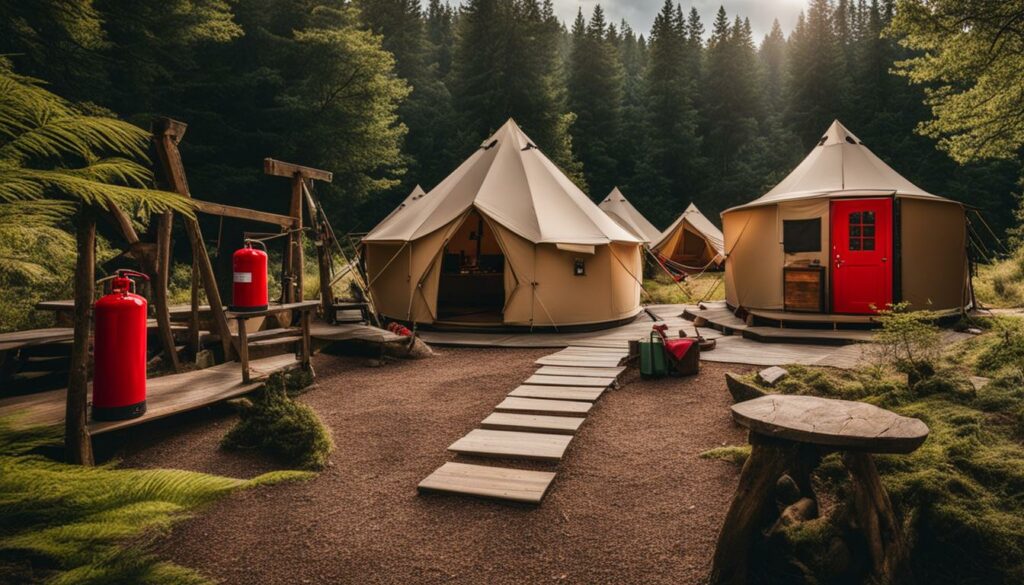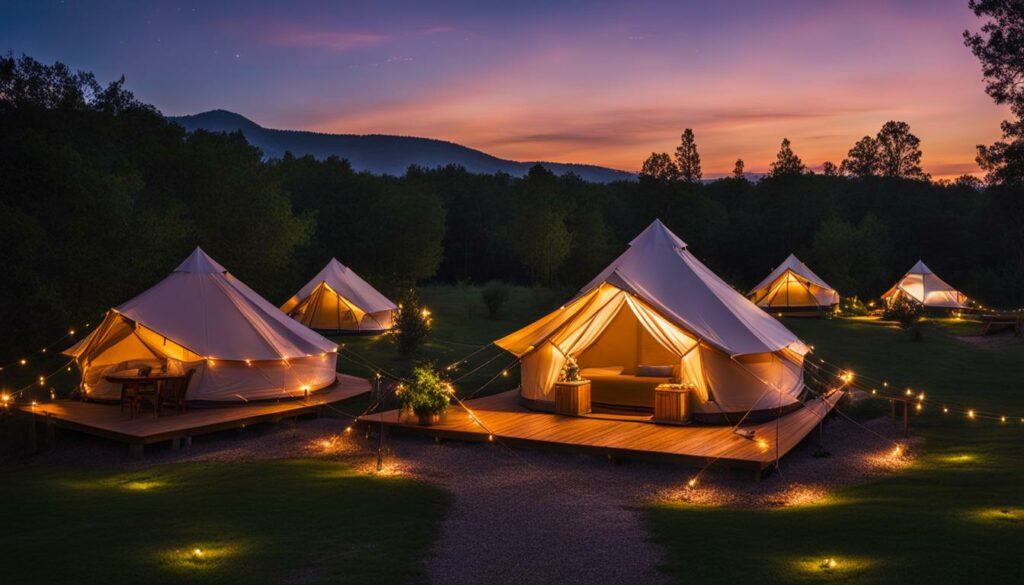Glamping, a luxurious form of camping that has gained immense popularity in recent years, is considered an excellent way to explore the great outdoors. However, with adventure comes risk, and thus ensuring guest safety should be a top priority for glamping site managers. Implementing effective safety measures in glamping sites is crucial to create a safe environment for guests and their families to enjoy their vacation. From fire safety precautions to conducting regular safety assessments, every aspect must be considered to minimize potential risks.
Key Takeaways
- Ensuring safety in glamping sites is critical to create a secure environment for guests and families.
- Fire safety precautions, regular safety assessments, and risk management are some measures that need to be implemented in glamping sites.
- Proper training and education on guidelines and protocols should be provided to site managers and guests to ensure compliance and collaboration.
- Hygiene and sanitation standards, adequate lighting, and security measures are also crucial factors that can influence the safety of a glamping experience.
- By implementing a safety-first approach, glamping site managers can create a secure and enjoyable vacation for every guest.
Understanding Glamping Site Safety Guidelines
Glamping sites must prioritize safety to ensure an enjoyable outdoor experience for guests. This section outlines specific safety guidelines and protocols that should be implemented.
Glamping Safety Standards
Industry standards dictate that glamping sites should have comprehensive safety measures in place. These include:
- Properly maintained accommodation units
- Fire safety precautions, such as smoke detectors and fire extinguishers
- Adequate lighting in common areas and inside accommodation units
- Properly grounded electrical installations
- Sanitary and hygienic bathroom facilities
- Effective communication with guests about safety guidelines
Some states and countries have specific safety regulations that glamping sites must adhere to. It’s essential to research and comply with these standards in addition to industry standards.
Glamping Safety Guidelines and Protocols
Glamping sites should also have their own safety guidelines and protocols tailored to their specific site and accommodations. These guidelines should be communicated effectively to guests upon arrival and should cover:
- Emergency procedures and evacuation plans
- Risk management protocols and assessments
- Proper use of electrical appliances
- Weather and natural disaster preparedness
- Guidelines for food storage and preparation
Importance of Glamping Safety Protocols
Effective safety protocols are essential to mitigate potential risks and to provide guests with a safe and enjoyable outdoor experience. Glamping sites that prioritize safety will attract more guests and retain their loyalty by ensuring their well-being.
Conducting Safety Assessments and Risk Management

Regular safety assessments are essential at glamping sites to ensure that all potential safety risks are identified and addressed promptly. This proactive approach to risk management not only enhances the safety of guests but also minimizes the damages and liabilities that may arise from accidents or incidents.
Conducting safety assessments involves a detailed evaluation of all aspects of the glamping site, including the accommodations, common areas, and outdoor facilities. The goal is to identify potential hazards, such as uneven or slippery walking surfaces, exposed electrical wiring, or unsecured structures. Once potential risks have been identified, steps can be taken to mitigate them.
Did You Know? According to a study by the Glamping Association, 75% of glamping site accidents are preventable with proper risk management.
Developing and implementing a comprehensive risk management plan is crucial for any glamping site. This plan should detail the steps that will be taken to manage identified risks, the personnel responsible for carrying out these steps, and the resources required. Additionally, regular updates to the risk management plan must be made to ensure that it remains effective.
Glamping site owners must also be proactive in educating their staff and guests about the importance of safety and risk management. Providing training on safe practices and emergency response protocols can help minimize the risk of accidents and ensure that everyone is prepared in case of an emergency.
Ensuring Effective Risk Management at Glamping Sites
| Steps for Conducting Safety Assessments | Overview of Risk Management Plan |
|---|---|
| 1. Conduct a thorough evaluation of the glamping site, identifying all potential hazards | 1. Detailed plan outlining the steps that will be taken to manage identified risks |
| 2. Prioritize risks based on severity and likelihood of occurrence | 2. Designation of personnel responsible for implementing the risk management plan |
| 3. Develop a comprehensive risk management plan to address identified risks | 3. Allocation of necessary resources for executing the plan effectively |
| 4. Regularly review and update the risk management plan | 4. Schedule for assessing and updating the risk management plan |
To ensure effective risk management at glamping sites, it’s crucial to be proactive in identifying and managing potential hazards. By conducting regular safety assessments, implementing a comprehensive risk management plan, and educating staff and guests about safe practices, glamping site owners can enhance the safety of their guests and minimize the risk of accidents and liabilities.
Ensuring Glamping Site Security
Guest safety is a top priority for any glamping site. Security measures can help ensure peace of mind for both guests and site owners. There are several measures that can be implemented to ensure the safety and security of glamping sites.
Surveillance Cameras
Installing surveillance cameras can help deter criminal activity and protect guests from potential threats. Cameras can be placed in common areas and around the perimeter of the site to monitor any suspicious activity. These cameras can be monitored by trained security personnel or site staff to ensure a rapid response to any incidents.
Access Control Systems
Access control systems can help prevent unauthorized entry to the site and keep guests safe. Options include coded entry gates, key card access, or biometric scans. These measures will ensure that only authorized personnel or guests can enter the site.
Security Personnel
Hiring trained security personnel can help enhance the safety and security of a glamping site. They can monitor the site for any suspicious activities and provide a quick response to any security breaches or emergencies.
The implementation of appropriate security measures can help to ensure that guests feel safe and secure during their stay. By demonstrating a commitment to security, guests will be more likely to return and recommend your glamping site to others.
Fire Safety Precautions at Glamping Sites

Fire safety is paramount at any glamping site. According to The National Fire Protection Association (NFPA), there were an estimated 2,500 structure fires in “camping areas” between 2013-2017. To reduce the risk of fire incidents and ensure the safety of guests, glamping sites need to implement appropriate fire safety measures.
One of the most critical aspects of fire safety is the presence of the right equipment. Glamping sites must have working fire extinguishers placed in key locations for easy access. It’s essential to ensure that all staff members know how to use them correctly and determine the type of fire before use. Smoke detectors should also be installed in all accommodation units and common areas, and they should be regularly tested to ensure they are working correctly.
In case of a fire incident, it’s critical to have a clear fire evacuation plan in place. All glamping sites must create a detailed evacuation plan that includes routes to leave the site, along with emergency phone numbers. Every guest must be informed of the fire evacuation plan upon arrival at the site. It’s also essential to practice the evacuation plan regularly to ensure that all guests and staff are familiar with it in case of an emergency.
Weather and Natural Disaster Preparedness
Glamping sites need to be prepared for emergencies such as severe weather conditions and natural disasters to ensure guests’ safety. It is essential to have a well-crafted emergency plan in place, providing clear direction on what to do in case of an emergency, who to contact, and how to evacuate safely.
When developing an emergency plan, glamping site managers should conduct a thorough risk assessment to identify potential risks. This assessment should consider the site’s location, weather patterns, and natural terrain features that can impact safety, such as nearby water sources, mountains, or forests.
Once the risks have been identified, appropriate safety measures should be implemented, such as installing alarm systems and emergency lighting, training staff and guests on evacuation procedures, and designating a safe assembly point. The emergency plan should be regularly updated and communicated to all guests and staff.
Other weather-related precautions that can be taken include monitoring weather forecasts and ensuring guests are aware of approaching weather systems by placing signage, providing updates through communication technology, or implementing an alert system.
Preparedness for natural disasters such as earthquakes, floods, and wildfires should also be considered. Managers should be aware of the probability of such incidents and have an emergency plan in place to ensure the safety of guests.
An essential element of a disaster preparedness plan is to identify and maintain communication with local emergency services, such as fire departments, hospitals, and rescue teams. It is critical to ensure that first responders have easy access to the site and can reach it quickly if needed.
Examples of Natural Disasters and Safety Measures
| Natural Disaster | Safety Measures |
|---|---|
| Earthquake | Regular building inspection and reinforcement, evacuation plans, designated safe zones away from buildings, emergency kit preparation |
| Flood | Proper drainage system, elevation of essential site components above ground level, evacuation plans, shelter-in-place provisions |
| Wildfire | Proactive vegetation management, designated fire lanes, fire-resistant building materials, evacuation plans, emergency response training |
Safe Electrical Installations and Usage

When it comes to glamping safety guidelines, ensuring safe electrical installations and usage should be a top priority for any glamping site. Faulty electrical systems can cause serious injuries or even fires, putting the safety of guests at risk.
Regular electrical inspections are crucial to identifying and addressing potential hazards. Guests must be made aware of the importance of reporting any electrical issues immediately to the staff to prevent accidents from happening.
Proper grounding of electrical systems is essential to reducing the risk of electrical shock. All electrical equipment must be professionally installed and regularly maintained, while following standards set forth by the National Electric Code. Guests should be instructed on how to safely use electrical appliances in their rental units.
While it is important to install electrical systems and equipment properly, it is equally crucial to make sure that guests use them safely and responsibly. Guests must be informed about the potential dangers of improper use of electrical appliances and encouraged to read manuals and instructions before operating them.
Electricity can be deadly, but taking the necessary safety precautions and implementing a comprehensive electrical safety plan can help prevent accidents and ensure that guests have a safe and enjoyable stay at your glamping site.
Ensuring Hygiene and Sanitation Standards
Glamping sites must uphold stringent hygiene and sanitation standards to ensure the safety and comfort of guests. Clean drinking water, proper waste disposal, and maintaining clean and sanitary bathroom facilities are crucial aspects to consider when implementing glamping safety protocols.
| Hygiene and Sanitation Measures: | Why They Matter: |
|---|---|
| Regular cleaning and disinfection of bathroom facilities | Clean facilities prevent the spread of harmful bacteria |
| Proper disposal of waste and garbage | Avoids attracting pests and vermin, which can pose health risks to guests |
| Providing guests with access to clean and potable drinking water | Drinking contaminated water can cause serious illnesses |
Implementing these measures demonstrates a commitment to glamping safety protocols and ensures that guests can enjoy a safe and comfortable stay. Additionally, glamping sites should regularly monitor and improve their hygiene and sanitation practices, and educate their staff on proper maintenance and cleaning procedures.
Providing Adequate Lighting for Safety

One of the essential glamping safety measures is to ensure adequate lighting throughout the site to prevent accidental falls and injuries. Proper lighting not only adds to the ambiance but also provides a sense of security and comfort to guests during the dark hours of the night.
The glamping site’s lighting system should primarily focus on lighting up pathways, walkways, and common areas such as the dining area, campground, and restrooms. Guests must be able to navigate their movements around the site without any difficulty or risk of tripping. Therefore, pathway lighting should be placed along the entire route to guest accommodations and essential amenities.
Accommodation units must also provide guests with an adequate amount of in-room lighting. Glamping tents and lodges often benefit from the natural light during the day. Still, additional light fixtures will enable guests to enjoy a comfortable and safe night-time experience. It’s essential to keep in mind that the lighting fixtures should be positioned correctly to prevent burns or fires.
In addition to standard light fixtures, using solar-powered lights can be a sustainable solution and be eco-friendly. These lights work by capturing and storing the sun’s energy in batteries during the day and can be used at night for lighting. Another eco-friendly lighting option is to use energy-efficient LED bulbs that consume less energy and last longer.
Educating Guests on Safety Guidelines
Ensuring the safety of guests is of utmost importance at glamping sites, and one major step toward achieving this goal is by educating them about safety guidelines and protocols. Glamping sites should make sure to communicate these guidelines in a way that is easily understandable and accessible to guests.
Effective ways to communicate safety guidelines to guests include:
- Providing welcome packets that include safety guidelines and protocols.
- Posting signage in visible areas such as common areas, accommodation units, and bathrooms.
- Conducting on-site briefings during check-in or at designated times during the guest’s stay.
By educating guests on safety guidelines, glamping sites can ensure that everyone is aware of what is expected of them and can take the necessary precautions to stay safe. This not only protects guests but also helps to create a safe and enjoyable glamping experience for everyone.
“It is important for glamping sites to communicate safety guidelines effectively and make sure their guests are aware of them. This ensures a safe and enjoyable experience for everyone involved.”
Conclusion
In conclusion, the safety and security of guests should be the top priority for glamping site owners and operators. Implementing effective safety measures, adhering to industry guidelines, conducting regular safety assessments, and ensuring proper risk management are key steps towards providing a secure and enjoyable outdoor experience. Maintaining proper hygiene and sanitation standards, providing adequate lighting, and educating guests on safety guidelines are also crucial aspects of ensuring glamping site safety.
By taking these measures seriously and investing in the necessary resources, glamping site operators can create a safe and enjoyable environment for their guests to make lasting memories. Remember, safety is not an afterthought, but rather an integral component of the glamping experience that should be prioritized to ensure the wellbeing of all visitors.
FAQ
What are glamping site safety measures?
Glamping site safety measures refer to the protocols, guidelines, and precautions implemented to ensure the safety and security of guests. These measures encompass various aspects such as fire safety, risk management, site security, hygiene standards, and more.
What are some important glamping safety guidelines and protocols?
Glamping safety guidelines and protocols include conducting regular safety assessments, implementing emergency preparedness plans, ensuring site security through measures like surveillance cameras and access control, maintaining proper hygiene and sanitation standards, providing adequate lighting, and educating guests about safety protocols.
How can glamping sites ensure risk management and safety?
Glamping sites can ensure risk management and safety by conducting thorough safety assessments, identifying potential risks, implementing proactive risk management strategies, and regularly reviewing and updating safety protocols. This helps minimize hazards and ensures the wellbeing of guests.
What are some security measures that should be in place at glamping sites?
Glamping sites should have security measures such as installing surveillance cameras, implementing access control systems to restrict unauthorized entry, hiring security personnel, and establishing clear procedures for handling security incidents. These measures help create a safe environment for guests.
What fire safety precautions should be taken at glamping sites?
Fire safety precautions at glamping sites include having fire extinguishers readily available, installing smoke detectors, implementing fire evacuation plans, and conducting regular fire safety training for staff and guests. These measures help minimize the risk of fire incidents and ensure prompt response in case of emergencies.
How should glamping sites prepare for severe weather conditions and natural disasters?
Glamping sites should have emergency preparedness plans in place to deal with severe weather conditions and natural disasters. This includes having evacuation plans, designated safe areas, emergency supplies, and clear communication channels for guests. Regular training and drills should also be conducted to ensure readiness.
What are the key aspects of safe electrical installations and usage at glamping sites?
Safe electrical installations and usage at glamping sites involve regular inspections of electrical systems, proper grounding, and adherence to electrical safety standards. Guests should also be provided with guidelines on using electrical appliances safely to prevent accidents or electrical hazards.
What hygiene and sanitation standards should glamping sites uphold?
Glamping sites should maintain clean drinking water sources, implement proper waste disposal systems, and ensure clean and sanitary bathroom facilities. Regular cleaning and maintenance routines should be followed to uphold hygiene and sanitation standards for the wellbeing of guests.
Why is adequate lighting important at glamping sites?
Adequate lighting is essential at glamping sites to ensure the safety and security of guests. This includes having proper pathway lighting, well-lit common areas, and sufficient lighting inside accommodation units to prevent accidents, improve visibility, and create a comfortable and secure environment.
How can glamping sites educate guests about safety guidelines?
Glamping sites can educate guests about safety guidelines by providing welcome packets or guidebooks that include safety information, displaying signage in common areas, and conducting on-site briefings to communicate important safety protocols. Clear and concise communication helps guests understand and adhere to safety guidelines.





